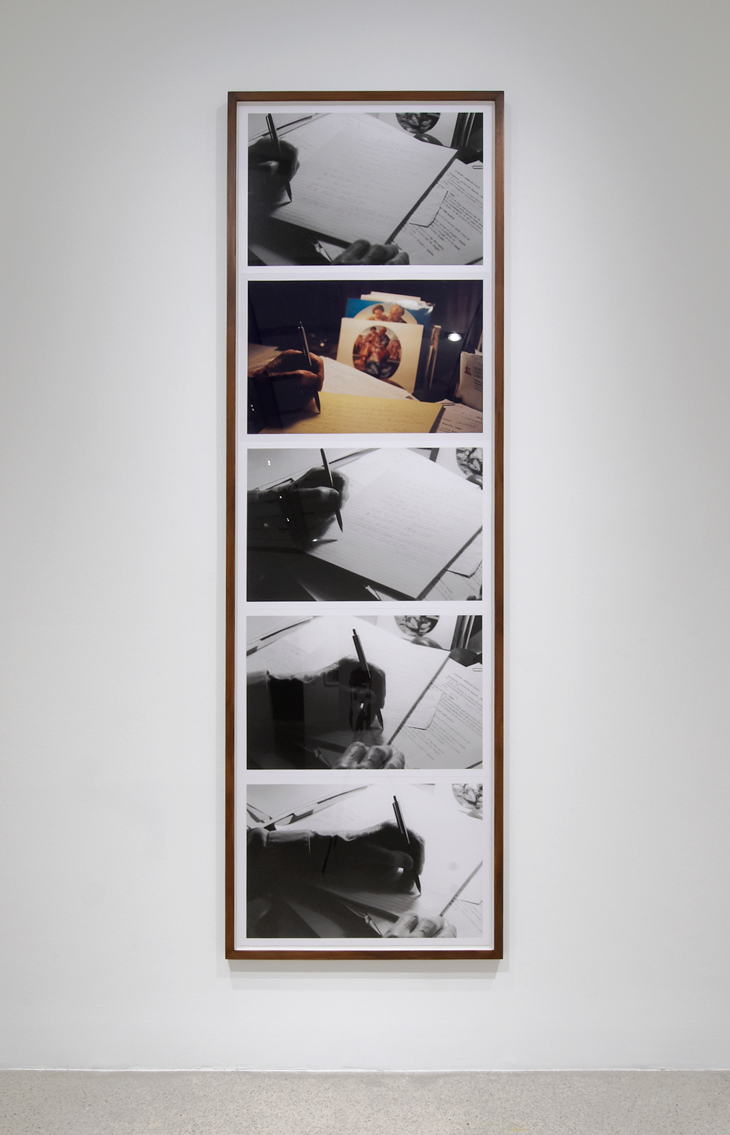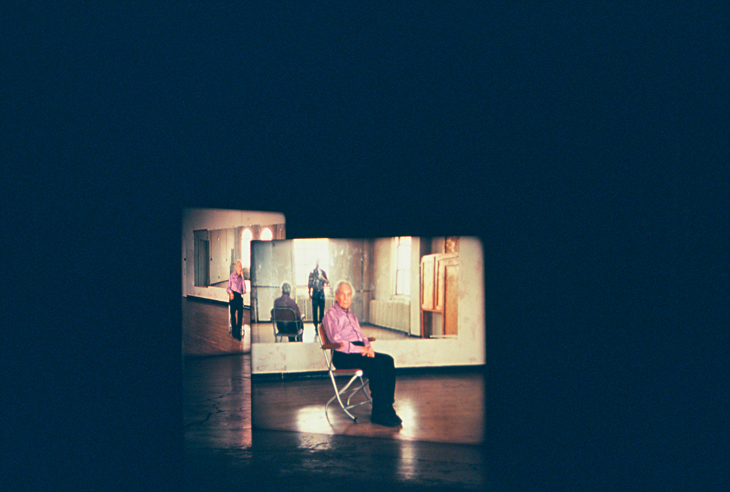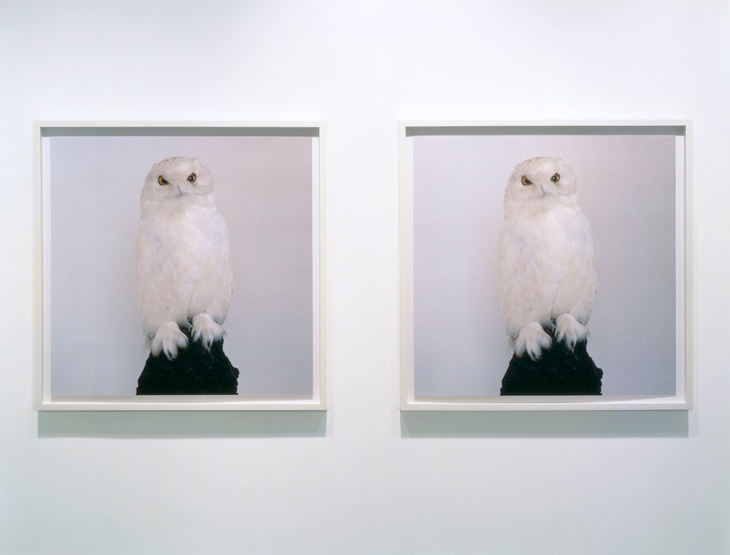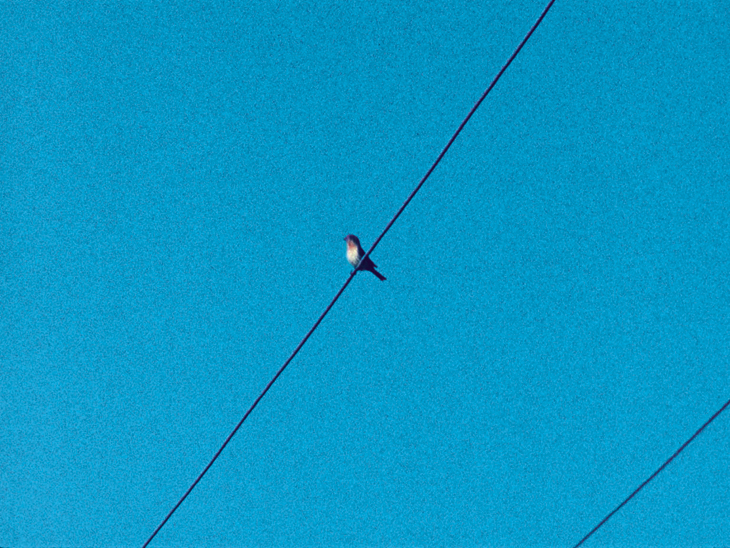Film – proper, old-fashioned analogue film, screened using one of those hulking projectors that generate nearly as much heat and sound as light – is Tacita Dean’s medium and, in many ways, her subject. Her current exhibition at the National Portrait Gallery (NPG) in London, the institution claims, holds the distinction of being its first ever show ‘to be devoted to the medium of film’. It may come as a surprise, then, upon entering the exhibition, to find the walls of the space covered in photographs.
There are the 51 photos that make up Dean’s unconventional ‘portrait’ of Cy Twombly, all taken at the artist’s home and studio in the Italian town of Gaeta (with the exception of one, from the studio of Giorgio Morandi) – none of which depict the face of their purported subject. The same goes for Dean’s other photographic portrait in this exhibition, of art historian Leo Steinberg. Five framed photographs are displayed in a vertical column. In the images, four black-and-white and one in colour, we see Steinberg’s hands up close as he writes with his left hand on a pad of lined paper. The work is titled The Line of Fate (2011), after Steinberg’s famous essay from 1980, which argued for the significance of a diagonal that can be discovered travelling from the top left to the bottom right of the paintings of Michelangelo. In his essay, Steinberg put forth the claim that ‘the work’s ultimate meaning flows in the geometry of its structure’.

The Line of Fate (2011), Tacita Dean. Installation view, MUMOK, 2011. Photo: Lisa Rastl; courtesy the artist. Frith Street Gallery, London and Marian Goodman Gallery, New York/Paris; © Tacita Dean
Standing out against the background noise of the academic’s busy desk, which is covered in postcards and printed sheets and paperclips and envelopes, a clear diagonal line emerges in Dean’s sequence of images: the line of Steinberg’s tilted pen, travelling from the top-right corner of the first image to the bottom-right of the last. The fateful diagonal is derived from two things: the sequential nature of the images, and the shifting perspective of the lens trained on its subject. The photos may be still, but this is clearly the work of an artist thinking with and through moving image.

Merce Cunningham performs STILLNESS… (six performances, six films) (2008), Tacita Dean. Installation view. Courtesy the artist, Frith Street Gallery, London and Marian Goodman Gallery, New York/Paris; © Tacita Dean
At the same time, The Line of Fate invokes the inheritance of a medium much older than film or photography: painting, stretching back to Michelangelo and beyond. (Before taking up the camera, Dean trained as a painter.) Dean’s film work is characterised by long, meticulously framed takes in which the camera remains in a fixed position, the elements of the projected or screened image arranged in harmonious composition. Her subjects – human, animal, organic – may move around or gradually alter, but sudden or dramatic movements are rare. In one work, the monumental Merce Cunningham performs STILLNESS … (six performances, six films) (2008), Cunningham choreographs his own performance to John Cage’s silent composition, 4’33’. Cunningham holds his pose for the camera, wordless and utterly still, save for the subtle, barely perceptible shifts that signal the transition between the performance’s three movements.
And then there’s that celluloid effect, imbuing the moving images with a richness, a sense of depth and tactility akin to the craquelure of a Renaissance oil. Could it be this painterly quality to Dean’s films that led the NPG, in collaboration with its neighbour the National Gallery, and the Royal Academy (whose offering I haven’t seen, as it doesn’t open until the end of May), to the decision to divide the present survey of her work into the three traditional painting genres – portraiture, landscape, still life? Dean is the first to admit that these genres are not something she particularly identifies with; writing in the exhibition catalogue, she expresses the frustrations of working with such discrete categories: ‘It goes well until you come across an anomaly, and the anomaly makes you create a new description and a new category, and it goes well again until the next anomaly and the next category, and so on and so forth.’

Dead Owl (1997), Roni Horn. Hauser & Wirth Collection, Switzerland Photo: Archive Hauser & Wirth Collection, Switzerland; courtesy Hauser & Wirth, London; © Roni Horn
This scepticism towards genre is equally evident in the exhibition Dean has curated at the National Gallery, where three of her films are displayed alongside two galleries of (sometimes loosely defined) still lifes arranged in associative groupings. The Head of Saint John the Baptist, by an unknown 16th-century Italian artist, hangs alongside a Thomas Demand snapshot of an elastic band placed on a stack of plates; Dean’s Prisoner Pair (2008), in which two pears dissolve in a jar of schnapps, is placed in dialogue with a couple of apples by William Henry Hunt. On one wall, a number of birds are collected, in various states of being: a stuffed specimen photographed by Roni Horn; a dead budgie in an anonymous flea market photo; Jacopo de’ Barbari’s 16th-century Sparrowhawk; and Dean’s own Ear on a Worm (2017), in which a songbird sits poised on a wire before, in the film’s final moment, diving off and vanishing beyond the frame. It’s a playful arrangement, silly even, but there’s also the hint of a more meaningful meditation on the strange, liminal role of a genre as defined by impermanence and death (‘nature morte’) as the depiction of life.

Ear on a Worm (2017), Tacita Dean. Courtesy Tacita Dean, Frith Street Gallery, London and Marian Goodman Gallery, New York/Paris; © Tacita Dean, Frith Street Gallery, London and Marian Goodman Gallery, New York/Paris
Dean is no stranger to the tradition of the memento mori. As the artist herself has remarked, ‘all the things I am attracted to are just about to disappear’: fruit dissolving in liquid; a bird soaring off in flight; an 89-year-old artist (Merce Cunningham, who died the year after STILLNESS was completed) paying homage to his late partner (John Cage); a crop of other portraits devoted to older painters, sculptors and poets; and the medium of film itself, which Dean pre-emptively eulogised in her grand commission – titled Film – for the Turbine Hall in 2011. If I were to make my own choice about the genre which best encapsulates Dean’s work, I’d be inclined to go for a poetic one: the elegy, a lament of loss. But from another perspective, the films are far from mournful. In their technical virtuosity and unabashed, luxuriant beauty, they come closer to striking a celebratory tone.
‘Tacita Dean: PORTRAIT’ is at the National Portrait Gallery, London, until 28 May; ‘STILL LIFE’ is at the National Gallery, London, until 28 May.












![Masterpiece [Re]discovery 2022. Photo: Ben Fisher Photography, courtesy of Masterpiece London](http://zephr.apollo-magazine.com/wp-content/uploads/2022/07/MPL2022_4263.jpg)
Apollo at 100